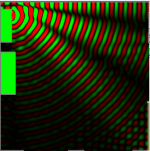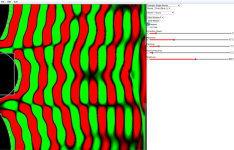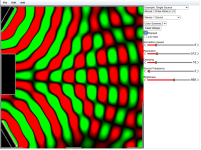Hey All,
I've been diving deep into the world of speaker design and bass response. Have you ever wondered why horns and larger speakers seem to have more "impact" than smaller ones, even when the SPL is the same? Let's unravel this together!
Currently, I'm working on designing a 40-400Hz woofer for my unity-based horn setup, and I've been experimenting with a ripple tank simulator (check it out here: https://www.falstad.com/ripple/) to simulate low-frequency room interactions and different configurations.
What I've noticed is that regardless of the subwoofer type, a single point source in the corner generates an initial wave followed by the entire room being excited. This leads to room modes dominating the sound we hear. However, when using multiple point sources across the room, I observed the excitement of every room mode, showcasing the complexity of bass propagation.


Now, let's investigate dipoles with baffle. They seem to produce a constant wave until they intersect, creating room-mode-like ripples.

But what if we replace that with a larger, continuous radiating source, like a wide-mouth horn? The result is a more directional sound wave along the wall, possibly explaining the "dynamic" sound of bass horns.

By angling the horns toward the listening position, interference can occur in the middle.

However, placing them further into the room, where the physical size of the horn positions the exit more towards the center, the direct waves seem to still dominate over room reflections. Note that this effect is particularly noticeable in the listening position in the center of the room.

(continued)
I've been diving deep into the world of speaker design and bass response. Have you ever wondered why horns and larger speakers seem to have more "impact" than smaller ones, even when the SPL is the same? Let's unravel this together!
Currently, I'm working on designing a 40-400Hz woofer for my unity-based horn setup, and I've been experimenting with a ripple tank simulator (check it out here: https://www.falstad.com/ripple/) to simulate low-frequency room interactions and different configurations.
What I've noticed is that regardless of the subwoofer type, a single point source in the corner generates an initial wave followed by the entire room being excited. This leads to room modes dominating the sound we hear. However, when using multiple point sources across the room, I observed the excitement of every room mode, showcasing the complexity of bass propagation.
Now, let's investigate dipoles with baffle. They seem to produce a constant wave until they intersect, creating room-mode-like ripples.
But what if we replace that with a larger, continuous radiating source, like a wide-mouth horn? The result is a more directional sound wave along the wall, possibly explaining the "dynamic" sound of bass horns.
By angling the horns toward the listening position, interference can occur in the middle.
However, placing them further into the room, where the physical size of the horn positions the exit more towards the center, the direct waves seem to still dominate over room reflections. Note that this effect is particularly noticeable in the listening position in the center of the room.
(continued)
Attachments
Last edited:
What if we explore a CBT (Constant Beamwidth Transducer) dedicated to low frequencies? Here's the idea: using a circular arc, I applied a series of point sources along with a single one strategically placed in the corner. The wall is then used to mirror the circular arc, inspired by Don Keele's CBT half-array against the wall. (frequency was accidentally adjusted higher, but you'll get the point)

Upon modeling a stereo pair configuration, I was pleasantly surprised to witness the consistent wavefront even in the presence of room modes. The simulation is pretty impressive, and I'm contemplating using a series of low-cost 6.5" woofers on a CBT array, positioned close to the floor to minimize speaker floor bounce. Another intriguing idea is to create two rows of CBT speakers, allowing for beam steering away from the floor by introducing delays.

But why stop there? I modeled the fireplace in the middle and wondered about the possibility of extending the continuous array across the entire room. The result was an entire wavefront that seemed to dominate the room modes. Seems impressive!

How about maintaining the arc, yet removing the center part? Not so impressive in this case.

Additionally, I simulated three discrete CBT arrays for a potential 3-channel approach, and it seemed similar to 2-channel CBT approach. this is interesting since the phase is different from the different speakers yet the direct sound seems to dominate the room modes.

Enter the realm of DSP (Digital Signal Processing). This approach seems to open up exciting possibilities for a compact, steerable low-frequency array that's room-friendly. Imagine maintaining a conventional-looking enclosure while utilizing DSP to apply shading and delay, similar to the physical CBT product.
I'm eager to hear your thoughts and experiences on this exploration!
Upon modeling a stereo pair configuration, I was pleasantly surprised to witness the consistent wavefront even in the presence of room modes. The simulation is pretty impressive, and I'm contemplating using a series of low-cost 6.5" woofers on a CBT array, positioned close to the floor to minimize speaker floor bounce. Another intriguing idea is to create two rows of CBT speakers, allowing for beam steering away from the floor by introducing delays.
But why stop there? I modeled the fireplace in the middle and wondered about the possibility of extending the continuous array across the entire room. The result was an entire wavefront that seemed to dominate the room modes. Seems impressive!
How about maintaining the arc, yet removing the center part? Not so impressive in this case.
Additionally, I simulated three discrete CBT arrays for a potential 3-channel approach, and it seemed similar to 2-channel CBT approach. this is interesting since the phase is different from the different speakers yet the direct sound seems to dominate the room modes.
Enter the realm of DSP (Digital Signal Processing). This approach seems to open up exciting possibilities for a compact, steerable low-frequency array that's room-friendly. Imagine maintaining a conventional-looking enclosure while utilizing DSP to apply shading and delay, similar to the physical CBT product.
I'm eager to hear your thoughts and experiences on this exploration!
Attachments
Last edited:
What are you looking at to determine this, the degree of pattern generation? I wouldn't say you'd hear those, not like that in any case.The result was an entire wavefront that seemed to dominate the room modes.



